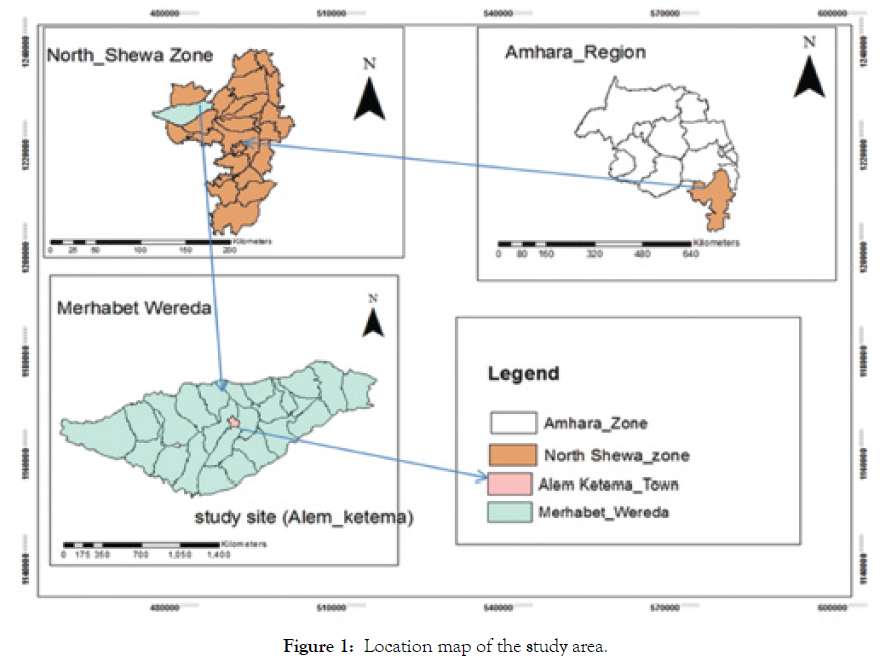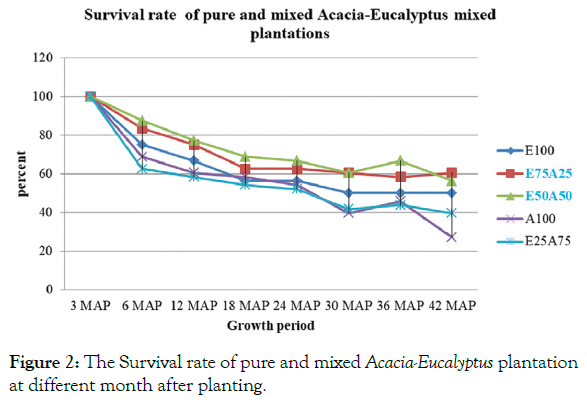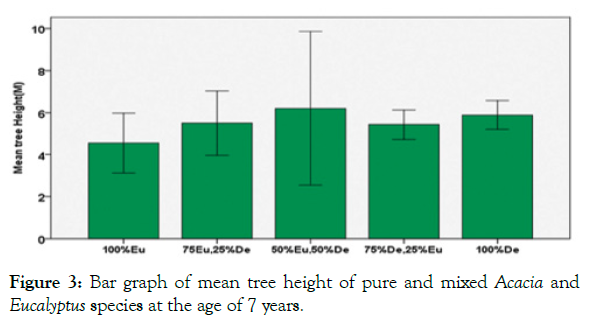Forest Research: Open Access
Open Access
ISSN: 2168-9776
+44 1300 500008
ISSN: 2168-9776
+44 1300 500008
Research Article - (2021)Volume 10, Issue 8
Eucalyptus plantation has been playing a vital role in narrowing the gap between the supply and demand for wood and wood products in the region. Though eucalyptus is fast-growing and has a better survival rate compared to other exotic species, there is a claim that Eucalyptus species over exploiting the nutrients and water. This consequently led to land degradation and soil fertility decline. Hence, it is important to develop mixed plantations to minimize the gap of monocultures. This study aimed to select Acacia decurrens-Eucalyptus Camaldulensis mixed plantation to obtain better woody yield and improve site productivity than sole plantation. A. decurrens and E.camladulensis seedlings were planted with the proportions of: 0%:100%, 100%:0%, 25%:75%, 75%:25% and 50%:50%. The experiment was arranged in a randomized complete block design with three replications. Results showed that the tree height and total volume not varied significantly between the mixed and pure stand plantations. Soil nitrogen varies significantly between the treatments. The plantation with 50% E.camaldulensis and 50% A.decurrens proportion had higher total nitrogen, organic carbon and organic matter in the soil. In line with the experiment, the farmers confirmed that the 50% E. camaldulensis with 50% A.decurrens plantations had relatively a better economic benefits and soil improvements. Further investigation is required to know the contribution of each species in soil nutrient addition. Investigation of the mixed plantation of exotic and indigenous is required to optimize economic and environmental benefits.
E.camaldulensis; A.decurrens; Mixtures; Growth; Yield
Eucalyptus is a genus that has more than 500 species. This genus is native to Australia, the Malaysian region, and the Philippines but it is planted in a different part of the world since the 1890s [1]. Eucalyptus is adaptable to tropical, arid and temperate regions of the world. It is one of the most widely planted trees in the world which covers around 20 million hectares of land. It is planted for paper pulp, fuel wood, timber, amenity plantings and land rehabilitation [2]. Plantations of eucalypts (species of Eucalyptus and Corymbia), particularly in the tropics and Southern Hemisphere, have expanded dramatically during the last 100 years [3].
Since the introduction, 55 and more species of eucalyptus grown in Ethiopia, of which between five and ten are widely planted [1]. E.globulus performs well in terms of growth and survival rate in highlands and E.camaldulensis the second most common eucalyptus species of ten grown in lower altitudes [4].
Increasing benefit from eucalyptus is an incentive for farmers to expand eucalyptus plantations at the expense of another land uses Engda TA, et al. [4], and also as a result of the availability of high demands for eucalyptus products the trend of expansion of eucalyptus plantation on crop and communal lands have been increasing. The market price for eucalyptus poles has grown to be 15 times greater over the last two decades [5-10].
Though fast-growing and have a better survival rate in degraded lands, there is a concern that mono-cultivation of eucalyptus has caused negative consequence in watershed management, soil and water conservation, wildlife habitat, and recreational values. Hence, to balance this, introducing an improved system could be an appropriate solution [11-14].
The mixed plantation is assumed to address more comprehensively the community needs of fuel and construction wood, nutrient cycle and the likes. Besides, different trees or shrub species are not equally affected by adverse environmental factors including drought, disease, and pests, and hence a mixed plantation avoids the risk of total failure or loss [6] studied that mixed stands of species of similar light demand (Eucalyptus globules and Acacia mearansi) in Australia and at age of 6.5 found highest stem volume when compared with the mixture of 50% Eucalyptus globules and 50% Acacia mearansii. This mixture provided 20% more than pure Acacia stand, and more than 120% pure Eucalyptus stand. This showed the necessity of developing mixed plantation to maximize economic benefits and ecologic effects.
Hence, study the best performing mixture of A.decurrens and E.camaldulensis plantation and comparing with the sole plantation is required to optimize the benefits. The objective of this study is to evaluate effect Eucalyptus and Acacia mixed plantation on woody yield, soil nutrient changes and the economic benefits.
Site description
The experiment was conducted in the high lands of the North shewa zone, Amhara Regional State of Ethiopia. Specifically, the study site is located in Merhabitie district, which is found in the south eastern part of Debere Birhan at a distance of 160 km south of Addis Abeba (Figure 1). The elevation of the study area reaches about 1931m.a.s.l, and the average annual rainfall ranges from 968 mm to 1486 mm.

Figure 1: Location map of the study area.
Experimental design
Seeds of E.camaldulensis and A.decurrens were purchased from Forestry Research Center (FRC) based at Addis Ababa, and raised in Alem Ketema nursery site. The treatments were arranged both a mixture and sole plantation. The proportions of Acacia decurrens: Eucalptus camaldulensis were 0%:100%, 100%:0%, 25%:75%, 75%:25% and 50%:50%. Explicitly, the treatments were Acacia decurrens sole plantation, Eucalyptus camaldulensis sole plantation, Acacia-Eucalyptus mixed (one after the other on alternative rows), Acacia-Eucalyptus (three rows of Eucalyptus with one row of Acacia), and Acacia-Eucalyptus (three rows of Acacia with one rows of Eucalyptus). The treatments were arranged in a randomized complete block design with three replications.
Each plot had a size of 6 m*6 m size and the number of seedlings per plots was 16. The spacing between seedlings was 2 m*2 m. The spacing between blocks and plots were 3 m and 2 m, respectively. At the beginning and end of the experiment, composite soil samples were collected from each treatment at 0-15 and 15. 1-30 cm depths. Soil physical properties (moisture content and bulk density) and chemical properties (organic carbon, total nitrogen and electric conductivity) were analyzed following the soil analysis procedures to investigate the difference before and after plantation. The economic effect of the mixed and sole plantation was assessed using the standard procedure. The data used for calculation were labor cost, estimated wood selling price, improvement/deterioration of soil fertility and social data.
Data
Growth parameters (root collar diameter, diameter at breast height and height), survival count, pest and disease data were collected every six-month interval until the end of the trial. Soil samples were taken at the beginning and end of the experiment. Input cost for (labor, seed purchasing, and management) and estimated the final selling price of the wood.
Data analysis
The volume of wood for standing trees was estimated by the following equation: V=0.44*B*H; Where V=tree volume (m3), B is tree basal area at breast height (m2) and H is tree height. Sample data were analyzed with ANOVA to see the differences among species mean for each variable measured. Least Significance Difference test (LSD) was used for multiple comparisons when significant differences were found between treatments. Descriptive and other statistical analysis (ANOVA) were carried out using SPSS version 20 software.
Growth performance
At the age of seven years, the overall mean height was 5.51 ( ± 0.87 SD) m. The minimum observed height was 3.93 m and a maximum 7.27 m for Eucalyptus and 50% Eucalyptus proportions, respectively. The mean DBH was 6.33 ( ± 1.44 SD) cm ranging from a minimum of 4.6 cm to a maximum of 9.5 cm (Table 1). The wood volume of the total stand was 21.12 m3/ha with a standard deviation of 1.46 (Table 2).
| Parameters | Minimum | Maximum | Mean | Std. Error | Std. Deviation |
|---|---|---|---|---|---|
| Ht (m) | 3.93 | 7.27 | 5.51 | 0.225 | 0.872 |
| DBH (cm) | 4.6 | 9.5 | 6.329 | 0.372 | 1.443 |
| V (m3/ha) | 7.18 | 48.31 | 21.12 | 3.31 | 1.46 |
Table 1: The mean value of the 7th year Acacia-Eucalyptus total plantation trial.
| The Proportion Of Tree Species In Each Treatment | Volume (m3/ha) |
|---|---|
| 100%, A. decurrens | 31.70 |
| 50:50%, E.camaldulensis:A.decurrens | 29.92 |
| 75:25%, E.camaldulensls:A.decurrens | 16.65 |
| 75:25%, A decurrens:E.camaldu ensls | 17.49 |
| 100%, E. camaldulensis | 9.873 |
| Mean | 21.12 |
Table 2: Mean volume (P=0.05 and Std. Error=7.12) of a pure and mixed stand of E. camaldulensis and A. decurrens at age of 7years.
A mix of 75% Acacia with 25% Eucalyptus and 50:50% of Acacia with Eucalyptus had shown a better survival rate compared to other treatments (Figure 2).Tree height was not significantly different among pure and mixed plantations (P > 0.05) but at the age of 7 years, 50:50% E.camaldulensis : A.decurrens showed the highest mean height (6.1 m) growth than other treatments, while pure E.camaldulensis had the lowest height (4.6 m) growth (Figure 3).

Figure 2: The Survival rate of pure and mixed Acacia-Eucalyptus plantation at different month after planting.

Figure 3: Bar graph of mean tree height of pure and mixed Acacia and Eucalyptus species at the age of 7 years.
The performance of the tree at the site might be a scribed to the soil conditions, especially poor nitrogen, at the trial site. The prime consideration for mixed plantation is the ecological requirements of species with climate, edaphic and topographic characteristics of the proposed planting site [15-18]. A careful selection of sites and species is, therefore, critical for successful establishment and improved growth performance of mixed plantations. Thus, a suitable mixtures hould provide growth opportunities for each species to result in synergy among them. As the interaction of different species very divergent it is not easy to a generalization about how species will grow in a mixed plantation. However, height-age curves of each species in monoculture and knowledge of the relative’s hade tolerances of each species should provide a useful basis for species selection.
Tree volume
The study showed that tree volume production was not significantly different among a pure and mixed plantation of E.camaldulensis and A.decurrens species (Table 3) but 50:50% E.camaldulensis and A. decurrens recorded slightly greater tree volume next to 100% A.decurrens. According to a study in Australia, a 6.5 year age of 50:50% E. globules and A.mearansii mixed stand found to have the highest stem volume than other treatments, 20% and 120% more than a pure Acacia and Eucalyptus stand, respectively.
| Treatments | PH | CEC | OC (%) | OM (%) | T.N (%) |
|---|---|---|---|---|---|
| 100% E.camaldulensis | 6.173 | 0.108 | 2.683 | 4.672 | 0.16 |
| 75: 25% A. decurrens | 6.39 | 0.125 | 2.694 | 4.633 | 0.137 |
| 50: 50% E.camaldulensi:A.decurrens | 6.333 | 0.157 | 3.24 | 5.572 | 0.2 |
| 25:75%, E.camaldulensi:A.decurrens | 6.557 | 0.132 | 1.705 | 2.93 | 0.13 |
| 100% A.decurrens | 6.507 | 0.125 | 2.659 | 4.57 | 0.157 |
| Control | 6.47 | 0.112 | 1.609 | 2.773 | 0.04 |
| Mean | 6.405 | 0.1265 | 2.437 | 4.191 | 0.1373 |
| Std. Error | 0.15 | 0.013 | 0.613 | 1.053 | 0.021 |
| Sig(5%) | ns | ns | ns | ns | *** |
Table 3: Mean values of soil pH, E.C, OC, TN under pure and mixed plantation (soil depth: 0-15 cm).
Economic returns of pure and mixed plantation
The price of tree products at immediate harvest was estimated by evaluating the market prices each treatment by participating in the local community. Whereas the costs of tree management was calculated by considering the major management activities and it was similar for all treatments. According to this result, the 50:50% E.camaldulensis: A.decurrens generated more money than others. It has high marginal net benefit and was a combination profitable treatment (Table 4).
| The Direct Benefit From | Indirect Benefit (Get | Total Gross | Field Cost | Net Benefits MNB% | ||
|---|---|---|---|---|---|---|
| Treatments | The Trees | From Grass) | Benefit | |||
| 100% Ec | 99518.5 | 6944.4 | 106463 | 24305.5 | 82157.4 | 2.8 |
| 75:25%, Ec Ac | 69333.3 | 6944.4 | 76277.7 | 24305.5 | 51972.2 | |
| 50:50% Eu :Ac | 102111 | 6944.4 | 109055.5 | 24305.5 | 84749.9 | 2.9 |
| 75:25% Eu :Ac | 70166.7 | 6944.4 | 77111.1 | 24305.5 | 52805.5 | |
| 100% Ac | 46370.7 | 6944.4 | 53314.8 | 24305.5 | 29009.2 | |
| Average | 77500 | 6944.4 | 84444.4 | 24305.5 | ||
Table 4: Estimated cost-benefit analysis of each treatment at the final 7th -year harevest, note all measurements are in Birr/ha base.
In conclusion, pure stands of E.camaldulensis and A.decurrens plantations showed the lowest survival and growth performance than mixed plantation. The tree height and total volume did not show a significant difference between the mixed and pure stands. However, mixed plantation resulted in improvement of soil nutrients. A mix of 50:50% E.camaldulensis: A.decurrens plantations scored higher total nitrogen than other mixed plantations. In addition, 50:50% of E.camaldulensis and A.decurrens plantations provided better net benefit than other plantations. From this study, a 50:50% E.camaldulensis and A.decurrens is recommended for mixed plantation there by to obtain relatively better economic benefits and soil improvements.
Citation: Nigussie MB, Habeteyohannes L, Teshome G, Ababu D, Tedila A, Eshetu R, et al. (2021) The Effect of Mixed Plantation on the Stand Yield and Soil Attributes of Eucalyptus globulus and Acacia decurrens in North Shewa Zone, Ethiopia. J Forest Res 10:282.
Received: 04-Aug-2021 Accepted: 23-Aug-2021 Published: 13-Sep-2021 , DOI: 10.35248/2168-9776.21.10.282
Copyright: © 2021 Nigussie MB, et al. This is an open-access article distributed under the terms of the Creative Commons Attribution License, which permits unrestricted use, distribution, and reproduction in any medium, provided the original author and source are credited.